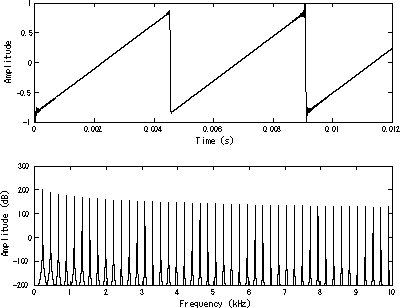A problem I ran into when I started to learn synthesizers was deciding what waveform to use. At first, it seems like it's clearly a preference of what type of waveform you want to use, but it is very important because it's the starting point of your sound. Usually, programmers pick the waveform first, and different waveforms have different purposes. For example, the sounds of a sawtooth are closer to that of strings, whereas the square wave is used for brassier sounds. Triangle waves can be mixed with noise to create synthetic drum sounds. Sine wave basses are popular in dance music.
Part of what makes these sounds so different is their harmonic content. Shown above is the sawtooth wave and its spectrum. The sawtooth wave has harmonic content at every interval. For a square wave, the harmonics only exist at the odd harmonics, making it sound more hallow. The triangle wave has fewer harmonics than those two, and the sine wave only has harmonics at its fundamental, making it the least rich sounding of the waveforms.
When choosing your waveform, be sure to consider how many harmonics you need, and what sound you are emulating. For example, I've found that the triangle works well for bell sounds, if you aren't using FM synthesis. FM synthesis requires a fair amount of knowledge of how these waveforms work if you're ever going to try to emulate a regular subtractive synthesizer, because as a user you need to understand what harmonics are going to be use by setting the ratios of the carriers in modulators. I will post a better explanation of FM synthesis later on.




No comments:
Post a Comment